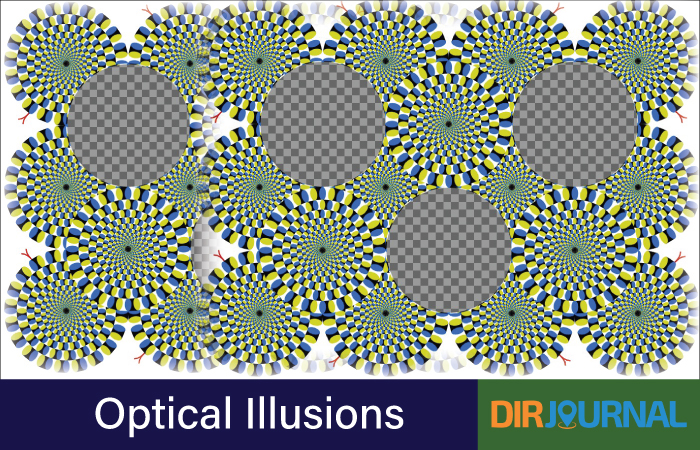An optical illusion which is also called a visual illusion can be described as perception of the images differently than they actually are. Our eyes see something, pass this info to the brain, and because of the different reasons and factors our brain makes us think that we see something different. Since I’m not a doctor myself and can’t write scientific explanations (though I do understand how it works) I use the material explaining the origin of illusions from Wikipedia.
Most of the illusions were discovered by psychologists and later people started using these effects to create new illusions. There are basically several main effects on a human eye and brain and multiple variations of the visual presentation of these effects. You might have seen multiple optical illusions online but we’d like to go just a bit deeper into it and show you the basics. Also, today we won’t speak about illusions where on once pic you can see multiple faces or should find say 10 people as these are more work of art of the painter than the illusion.
Basically there are 3 main type of optical illusions: literal optical illusions that create images different from the objects that make them, physiological illusions that we see as the result of eyes excessive stimulation of a specific type (brightness, tilt, color, movement), and cognitive illusions where the eye and brain make unconscious inferences.
Physiological illusions
We see this type of illusion as the effect on the eyes or brain of excessive stimulation of a specific type, such as brightness, tilt, color, movement etc. The most usual and well-known demonstration of these effects are the afterimages following bright lights or when you stare at some moving or still image for long and see other things move after that or when the image starts moving on its own. The theory is that stimuli have individual dedicated neural paths in the early stages of visual processing, and that repetitive stimulation of one or a few channels causes a physiological imbalance that alters perception.
Here are some pretty popular examples of illusions of this type.
Lilac chaser
Lilac chaser consists of 12 lilac blurred disks arranged in a circle around a small black, central cross on a gray background. One of the disks disappears briefly (for about 0.1 second), then the next (about 0.125 second later), and the next, and so on, in a clockwise direction. When one stares at the cross for about 20 seconds or so, one first sees a gap running around the circle of lilac disks, then a green disk running around the circle of lilac disks, then a green disk running around on the gray background, with the lilac disks having disappeared or having been erased by the green disk. This is due to an interesting effect in which the colors of the lilac disks are inverted in the optical illusion to a green color.

Peripheral drift illusion
The center of the image seems to be moving from left to right and top to bottom, when you move your eyes just a bit to a side from the center. The peripheral drift illusion refers to a motion illusion generated by the presentation of a sawtooth luminance grating in the visual periphery.
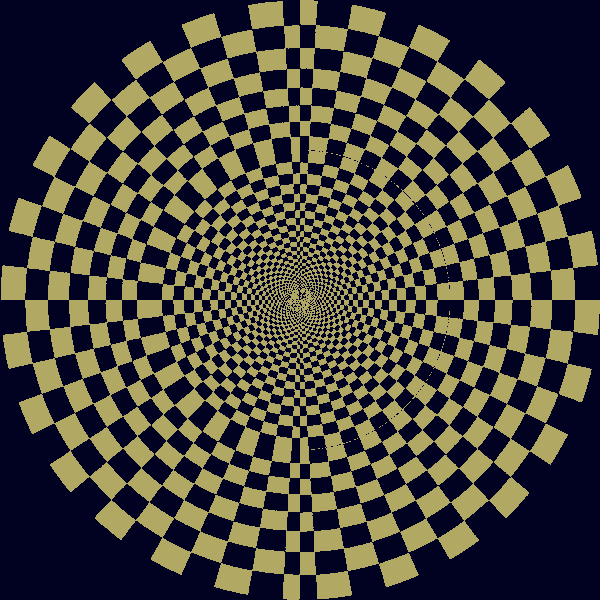
The red, white and blue flag.
Stare at the center of the weird flag for about 1 minute. Don’t move your eyes. Then look at an empty white sheet of paper, and you’ll see the red, white, and blue flag. This is an afterimage or ghost image, an optical illusion that refers to an image continuing to appear in one’s vision after exposure to the original image has ceased. If the viewer stares at the image for 20-60 seconds and stares at a white object, a negative afterimage will appear.
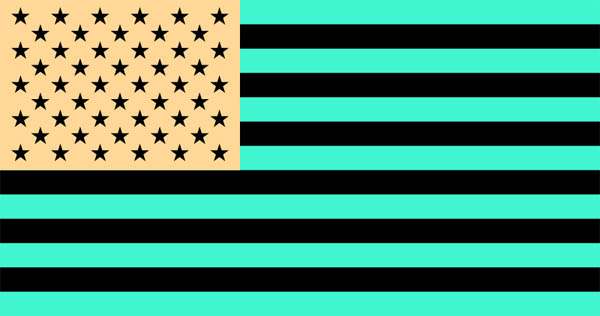
Black and Grey
Stare at the black dot… after a while, the gray haze around it will appear to shrink.
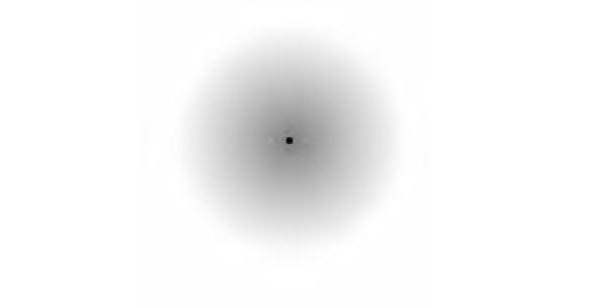
Hermann grid
This illusion is characterized by “ghostlike” gray blobs perceived at the intersections of a white (or light-colored) grid on a black background. The gray blobs disappear when looking directly at an intersection.
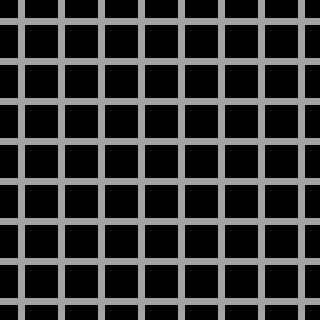
Jesus Christ
This illusion is pretty popular and a really great example of the afterimage effect.
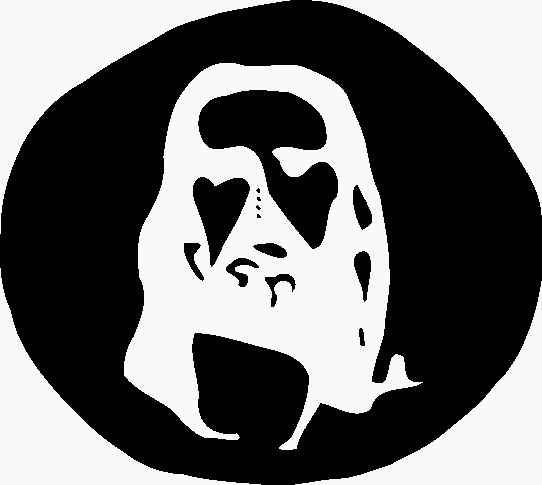
Che Guevara
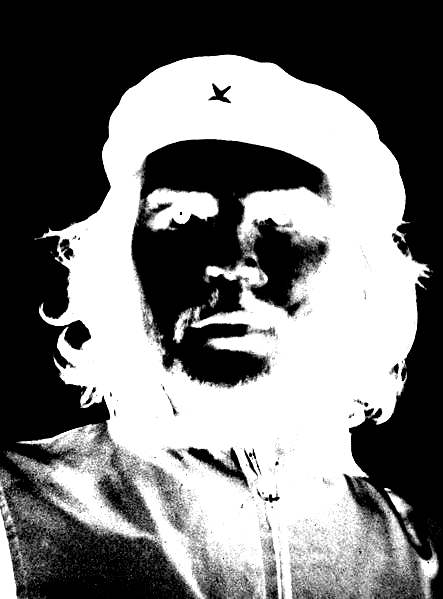
Color Dove illusion
In this effect, an empty (white) shape is presented on a colored background for several seconds. When the background color disappears (becomes white) an illusionary color, similar to the original background is perceived within the shape.
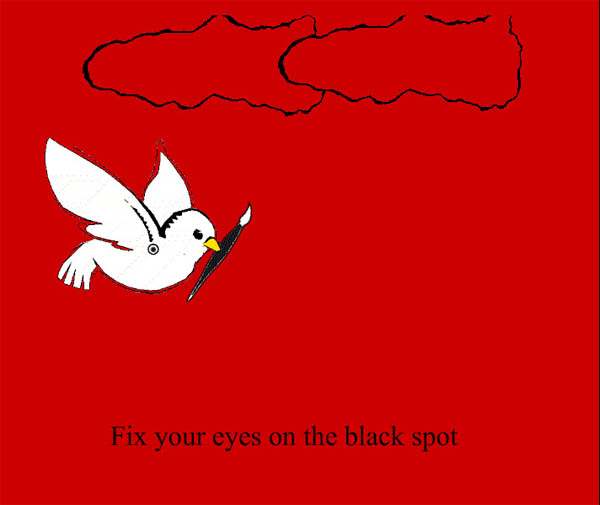
Bezold effect
The red seems lighter combined with the white, and darker combined with the black. Same about the rest of the colors when you see them on white and black. These color shades influence the way you see the other colors.
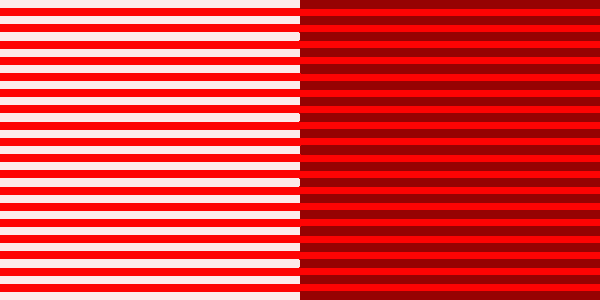
Cornsweet illusion
Left part of the picture seems to be darker than the right one. In fact they have the same brightness. We can see this effect because of the small gradient effect in the middle of the image.
Fraser spiral illusion
The illusion is also known as the false spiral, or by its original name, the twisted cord illusion. The overlapping black arc segments appear to form a spiral; however, the arcs are a series of concentric circles.
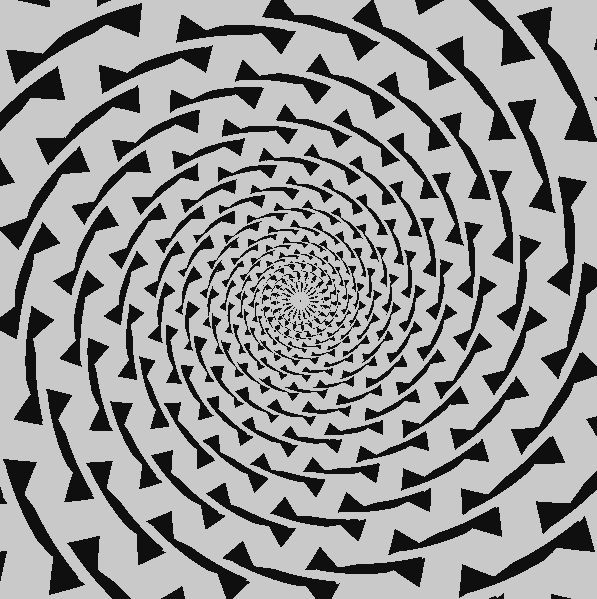
Short-Circuit Your Brain
Look at the chart above and say the COLOR of the word, not the word itself. With this illusion you can see how’s your brain working. One part of it tries to read and the second one sees the color.

Cognitive illusions
Cognitive illusions are assumed to arise by interaction with assumptions about the world, leading to “unconscious inferences,” an idea first suggested in the 19th century by Hermann Helmholtz. Cognitive illusions are commonly divided into ambiguous illusions, distorting illusions, paradox illusions, or fiction illusions.
1. Ambiguous illusions
Ambiguous illusions are pictures or objects that elicit a perceptual ‘switch’ between the alternative interpretations.
The Necker cube
The Necker Cube is a ambiguous line drawing. It is a wire-frame drawing of a cube in isometric perspective, which means that parallel edges of the cube are drawn as parallel lines in the picture. When two lines cross, the picture does not show which is in front and which is behind. This makes the picture ambiguous; it can be interpreted in two different ways. When a person stares at the picture, it will often seem to flip back and forth between the two valid interpretations (so-called multistable perception).

Isometric illusion.
The shape can be perceived as either an inside or an outside corner. In general, any shape built entirely of the same-length (i.e., isometric) lines that does not clearly indicate relative direction between its components will evoke such a perceptual “flip-flopping”.

Reversing Staircase
Stare at the Reversing Staircase Illusion until it changes to a different staircase.

Spinning Dancer
If the foot touching the ground is perceived to be the left foot, the dancer appears to be spinning clockwise (if seen from above); if it is taken to be the right foot, then she appears to be spinning counterclockwise.
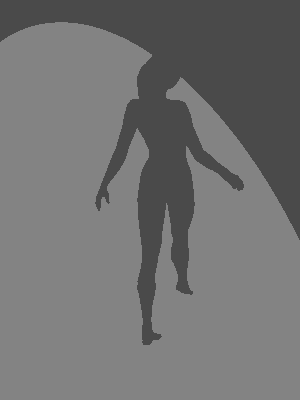
2. Distorting illusions
Distorting illusions are characterized by distortions of size, length, or curvature. Below you will find some nice examples.
Café wall illusion
This optical illusion makes the parallel straight horizontal lines appear to be bent. To construct the illusion, alternating light and dark “bricks” are laid in staggered rows. It is essential for the illusion that each “brick” is surrounded by a color between the dark and light color of the “bricks”.
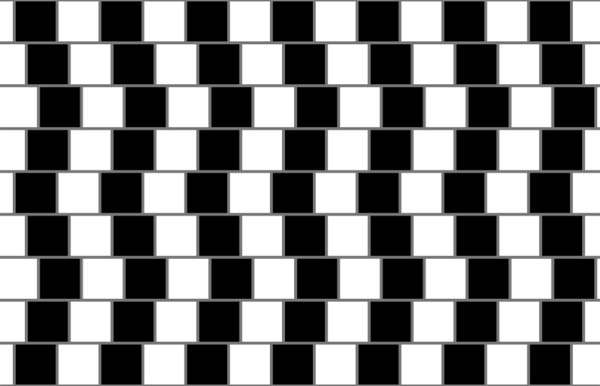
Müller-Lyer illusion
The Müller-Lyer illusion consists of nothing more than an arrow. When viewers are asked to place a mark on the figure at the mid-point, they invariably place it more towards the “tail” end. Another variation consists of two arrow-like figures, one with both ends pointing in, and the other with both ends pointing out. When asked to judge the lengths of the two lines, which are equal, viewers will typically claim that the line with inward pointing arrows is longer. One possible explanation is that one sees the lines as three-dimensional, such as the outgoing and ingoing corners of a room. Another possible explanation is that the line with arrows pointing inwards may simply appear longer because the arrows themselves extend past the line.

Ebbinghaus illusion
The two orange circles are exactly the same size; however, the one on the left seems smaller. We see the size differently because of the size of the objects around and the distance from them to the orange circles.

Ehrenstein illusion
The sides of a square placed inside a pattern of concentric circles take an apparent curved shape.
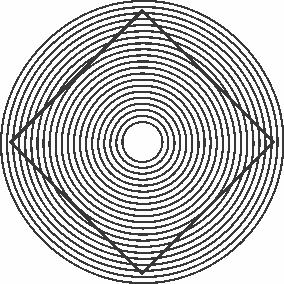
Hering illusion
The two vertical lines are both straight, but they look as if they are bowing outwards. The distortion is produced by the lined pattern on the background, that simulates a perspective design, and creates a false impression of depth.
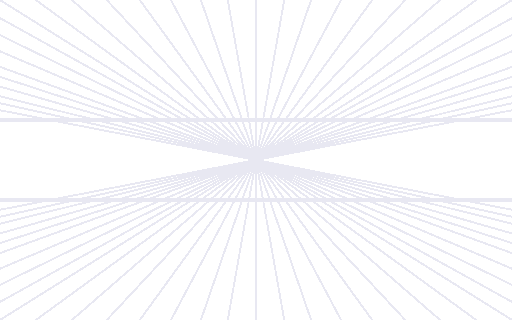
Jastrow illusion
The two figures are identical, although the lower one appears to be larger.

Kanizsa triangle
In the accompanying figure a white equilateral triangle is perceived, but in fact none is drawn. This effect is known as a subjective or illusory contour. Also, the nonexistent white triangle appears to be brighter than the surrounding area, but in fact it has the same brightness as the background.

Leaning tower illusion
The Leaning Tower Illusion is an optical illusion that presents two identical images of the Leaning Tower of Pisa side by side. Although the images are identical, we have the impression that the tower on the right leans more, as if photographed from a different angle.
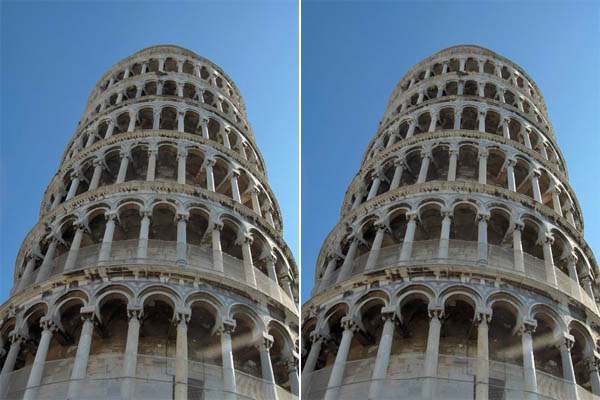
Illusory motion
The term illusory motion, also known as motion illusion, is used to define the appearance of movement in a static image. This is an optical illusion in which a static image appears to be moving due to the cognitive effects of interacting color contrasts and shape position.
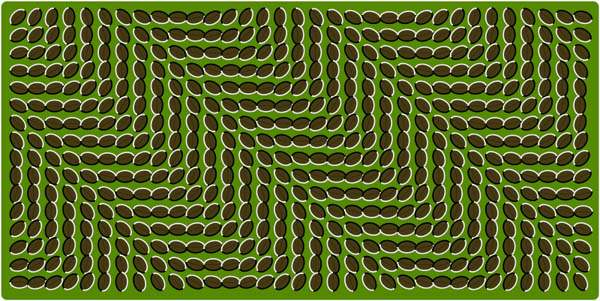
Poggendorff illusion
A straight black and red line is obscured by a grey rectangle. The blue line, rather than the red line, appears to be a continuation of the black one, which is clearly shown not to be the case on the second picture.

Same color illusion
The squares A and B on the illusion are the same color (or shade), although they seem to be different. This can be proven by copying the image into an art program and sampling the color of A and then of B, which will show that they are in fact the same color.
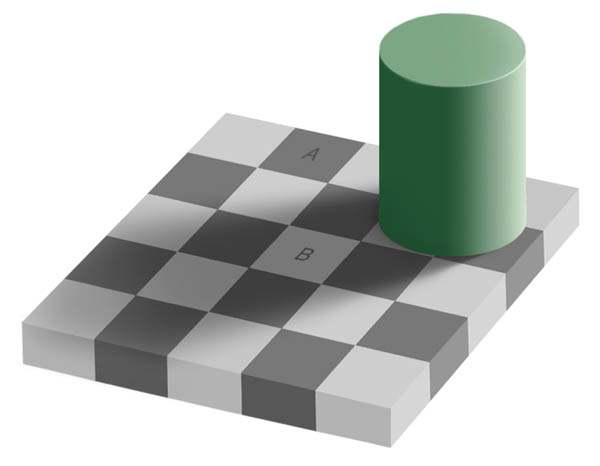
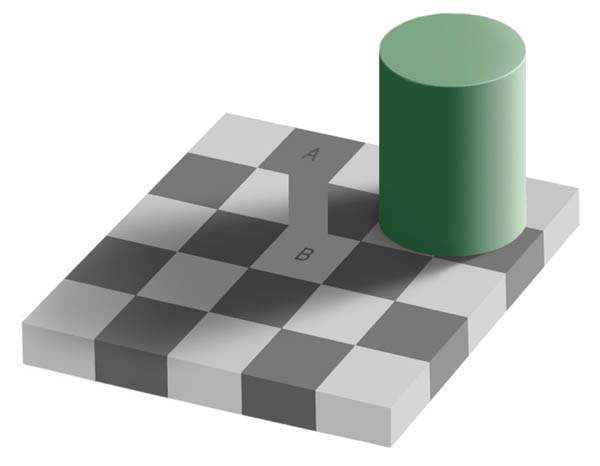
Zöllner illusion
In this figure the black lines seem to be unparallel, but in reality they are parallel. The shorter lines are on an angle to the longer lines. This angle helps to create the impression that one end of the longer lines is nearer to us than the other end. This is very similar to the way the Wundt illusion appears. It may be that the Zöllner illusion is caused by this impression of depth.
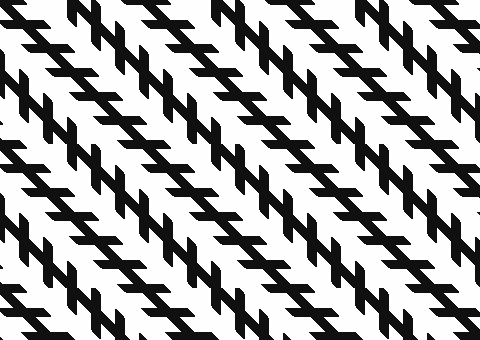
3. Paradox illusions
Paradox illusions are generated by objects that are paradoxical or impossible, such as the Penrose triangle or impossible staircases seen, for example, in M. C. Escher’s Ascending and Descending and Waterfall. The triangle is an illusion dependent on a cognitive misunderstanding that adjacent edges must join.
Penrose triangle
The tribar appears to be a solid object, made of three straight beams of square cross-section which meet pairwise at right angles at the vertices of the triangle they form.

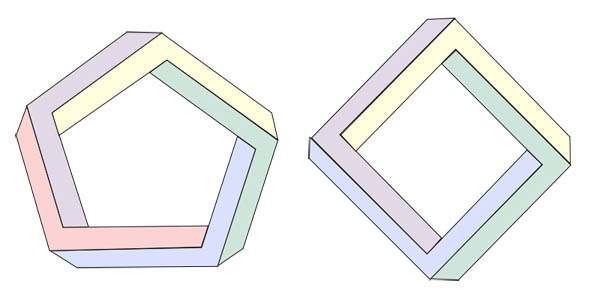
Blivet
This blivet portrays two irreconcilable perspectives at once, creating a “lost” layer between the top two rods, and an impossible extra, vanishing rod in between the bottom two.
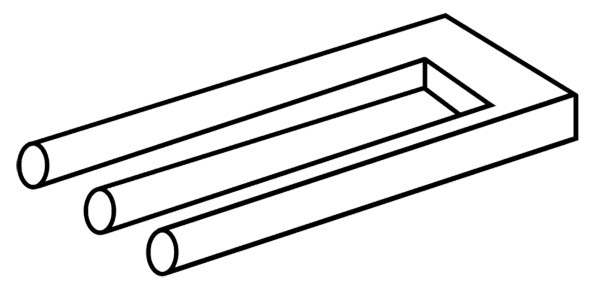
Impossible staircases
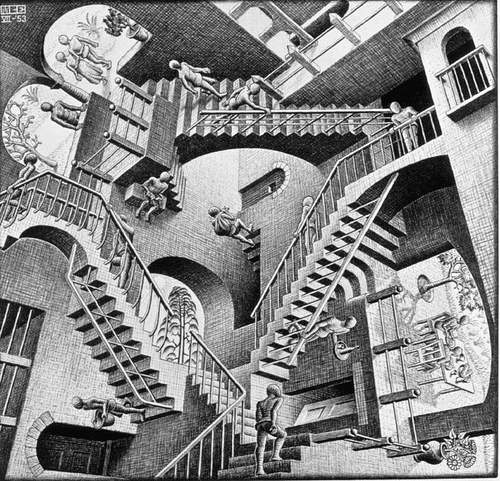
Ascending and Descending and Waterfall illusions
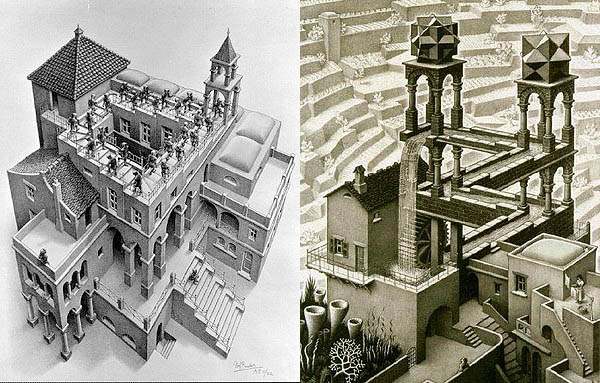
4. Fictional illusions
Fictional illusions are defined as the perception of objects that are genuinely not there to all but a single observer, such as those induced by schizophrenia or a hallucinogen. These are more properly called hallucinations.
Here’s an amazing website where you can see multiple illusions including some great animated illusions www.michaelbach.de. You will also find explanations to many effects so be sure to visit it if you’re interested in optical illusions.







